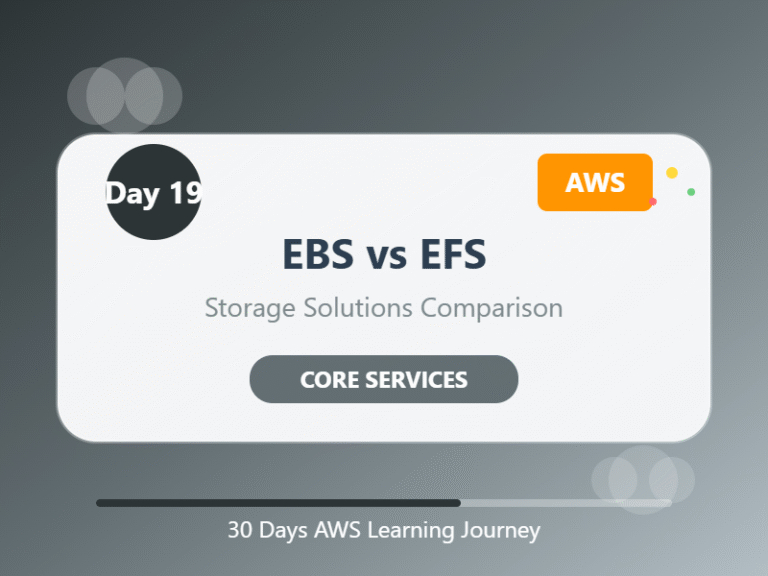💾 Day 19: S3 vs EBS vs EFS – AWS Storage Services Compared
Category: AWS Storage
Goal: Understand the 3 main storage types in AWS and when to use each.
🧠 What You’ll Learn Today:
- What is S3, EBS, and EFS
- Key differences
- Use cases for each
- Which one is best for your need
🪣 1. What is S3? (Simple Storage Service)
- Object storage for any type of file (images, videos, backups, etc.)
- Data is stored in “buckets” like folders
- Highly durable and scalable
- Accessed over the internet (via HTTP/S)
✅ Best for:
- Storing files, backups, logs
- Hosting static websites
- Application data (non-OS)
💽 2. What is EBS? (Elastic Block Store)
- Block storage for EC2 virtual machines
- Works like a hard drive for your EC2 instance
- Data is stored in volumes and can attach to 1 instance
- Fast and ideal for running OS and databases
✅ Best for:
- Boot volume for EC2
- Databases like MySQL/PostgreSQL
- High-speed apps tied to 1 instance
📁 3. What is EFS? (Elastic File System)
- File storage that multiple EC2 instances can access
- Works like a shared drive (like Google Drive for servers)
- Scalable and serverless file storage
- Supports standard file system interface
✅ Best for:
- Shared file access between apps
- Web server content
- Analytics workloads
⚖️ 4. Quick Comparison Table:
| Feature | S3 | EBS | EFS |
|---|---|---|---|
| Storage Type | Object Storage | Block Storage | File Storage |
| Attached To | None (web-based) | One EC2 instance | Multiple EC2s |
| Access Type | Web API (HTTP/S) | OS level disk | Mount like a drive |
| Scalable | Highly scalable | Limited per volume | Auto-scales |
| Use Case | Backups, files | OS, DB storage | Shared file system |
🧠 End of the Day Notes:
Think of storage like your own computer:
- 🪣 S3 = USB Drive (store and access anywhere)
- 💽 EBS = Internal Hard Drive (only for your machine)
- 📁 EFS = Network Drive (shared between computers)
Choosing the right storage in AWS depends on how your app uses the data.
🔁 Navigate the Series:
⬅️Day 18: RDS Introduction– Databases Made Easy on AWS
➡️Day 20: Backup & Recovery on AWS


